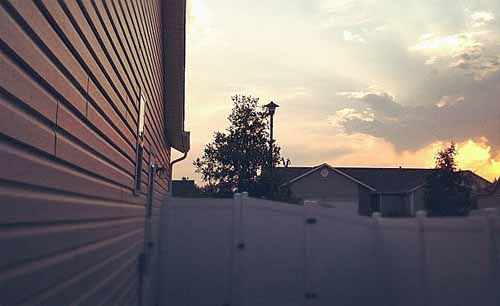Vinyl fences also have other advantages — such as their immunity to rust and rot — that make them well worth the investment for any savvy DIY-er.
But placing a vinyl fence doesn’t always work out exactly the way you think. And even if it does, changes to your yard or the environment around it could impact the integrity of your fencing.
One of the most common ways this happens is by a hole, divot, or gap forming underneath your fence. So what do you do if you have a gap underneath your vinyl fence? The short answer is simple — you fill it.
The long answer is more complicated. Here are some of the best ways to fill gaps under vinyl fences.
Dirt or Non-Stone Filler
Dirt or non-stone filler is one of the easiest ways to fill a small gap. However, there are a few limitations of what dirt is able to do when it comes to filling a divot in your fencing.
First, it’s important to recognize that dirt is a loose medium. This means you’ll have to use more than you think to pack it down and make a solid, reliable cover for your fence’s gap.
Second, it’s also important to recognize that dirt (or something similar) will not stop animals from digging underneath your fence. So if you’ve had problems with neighborhood dogs, raccoons, moles, or other diggers, they’ll be able to cruise right through the dirt you put down, even if you pack it tight.
Third, dirt is not a recommended filler for a hole around a main support post, especially if it’s a deep hole.
So when should you use dirt for your vinyl fence gap filler?
Essentially, dirt works great to fix shallow gaps that may show the underside of vertical fencing posts. It’s also handy if you want to build up around your fencing posts for whatever reason.
It’s also a great filler medium if you just had a heavy rain and some topsoil ran off of your property. This loss of topsoil could expose a lot of your fencing and create a long, ugly gap underneath.
If that happens to your fence, all you need to do is replace the dirt that was there. All you have to do is lay it down, pack it down, and move on.
Stone Filler
Stone filler is a heavier, denser, and more durable medium than dirt or other loose fillers. Stone is a great way to provide a thick, long-lasting foundation down underneath your fence. It works best if you use stone as a filler after your support beams go into the ground and before you establish your fencing in between.
However, you can also use stone — particularly small stones — to fill gaps that form underneath your vinyl fencing.
Stone filler is a great way to add extra strength to support beams if you’re losing material around your fencing’s foundation. The stone falls harder and sits more reliably than dirt, allowing you to not only fill a gap in your fencing, but also add much-needed strength to the structure of the fence itself.
Outside of that, larger stone can be used to fill non-structural areas underneath your fencing if you’re having issues with animals digging through dirt.
Stone adds the extra strength that keeps claws from getting underneath your vinyl fence. While it may not create a picture-perfect result — you could still have small gaps between the stone and your fencing — it’ll provide the protection your fence needs to keep it strong and stable for long periods of time.
Concrete
Concrete is the go-to option for any gap under your vinyl fence that is deep, wide, or surrounding a support post. Concrete is the perfect combination of the previous two fillers we’ve discussed — it enters a gap as a liquid, and it solidifies into a perfect mold of stone. This gives you the best of both worlds when it comes to a picture-perfect filler and a durable filler that stands up to animal invasion.
On the downside, concrete is labor-intensive and expensive, meaning you’ll put a lot more into filling your fence’s gaps than you would with either of the other two options we’ve mentioned. If you’ve never mixed concrete before, part of that labor also includes an element of trial and error.
If you mix it on site, concrete requires perfect proportions of different ingredients — often just water these days — that can make it pour well and solidify properly. Too much water may make the concrete too loose and solidify improperly. Too little water will make it challenging to pour and fit to the mold that you need.
As a result, mixing concrete is often the first hurdle you’ll encounter when you use it to repair a gap underneath a vinyl fence. But once you get the hang of it, it’s typically easier to do your next batches.
Still, that could be a good thing if you want to fill your fence’s gaps once and never again. Unlike the other two fillers we’ve discussed, concrete hardens as it ages, meaning that the oldest concrete is also the hardest concrete. As a result, it’s the one medium you can use to fill gaps underneath your fence that will actually become more reliable over time. Dirt and stone will degrade, but in almost every instance, concrete will improve as it ages in terms of strengthening your fencing.
This is a double-edged sword, though. If you think you might ever need to reposition or remove your fencing, then concrete will become much harder for you to destroy than dirt or stone. So if you’re sure you want your fence in the same position for years to come, concrete is the way to go. If you might change your mind, go with another option.
Good luck filling that pesky gap beneath your vinyl fence!


